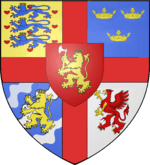Crown (heraldry)

A Crown is often an emblem of the sovereign state, a monarch's government, or items endorsed by it; see The Crown. Crowns may also be used by some republics.
A specific type of crown (or coronet for peerage in the British Isles) is employed in heraldry under strict rules. Indeed some monarchies never had a physical crown, just a heraldic representation, as in the constitutional kingdom of Belgium.
Crowns are also often used as symbols of religious status or veneration, by divinities (or their representation such as a statue) or by their representatives, e.g. the Black Crown of the Karmapa Lama, sometimes used a model for wider use by devotees.
A crown can be a charge in a coat of arms, or set upon the shield to signify the status of its owner. So the royal crown which shows a Christian cross on a coat of arms means that his or her holder has power and direct protection from God; if you find crown of the Duke, the owner is not Duke necessarily rather someone who has received power and protection with its power. Crowns bearing bird feathers refer to ancient beliefs, according to which the birds had divine qualities like angels communicated with the worlds beyond the sky. In Italy there are rings that show the city walls used symbolically to remember the function that had the walls to protect the city. Thus the crown is a symbol of power and protection received from someone or something or means that the owner of the crown you show guarantees you power and protection.
As a display of rank
If the bearer of a coat of arms has the title of baron or higher (or hereditary knight in some countries), he or she may display a coronet of rank above the shield, usually below the helm in British heraldry, often above the crest (if any) in Continental heraldry.
In this case the appearance of the crown follows a strict set of rules. A royal coat of arms may display a royal crown such as that of Norway. Princely coats of arms display a princely crown and so on right down to the mural crown which is commonly displayed on coats of arms of towns and some republics. Other republics may use a so-called people's crown or omit the use of crowns all together. The heraldic forms of crowns are often inspired by the actual appearance of the respective country's royal and princely crowns.
Ships and other units of some navies have a naval crown above the shield of their coats of arms.
Commonwealth usage

In formal English the word crown is reserved for the crown of a monarch whereas the word coronet is used for all other noble crowns.
In the peerage of the United Kingdom, the design of a coronet shows the rank of its owner, as in German, French and various other heraldic traditions. The coronet of a duke has eight strawberry leaves, that of a marquess has four strawberry leaves and four silver balls (known as "pearls", but not actually pearls), that of an earl has eight strawberry leaves and eight "pearls" raised on stalks, that of a viscount has sixteen "pearls", and that of a peerage baron or (in Scotland) lord of parliament has six "pearls". Between the 1930s and 2004, feudal barons in the baronage of Scotland were granted a chapeau or cap of maintenance as a rank insignia. This is placed between the shield and helmet in the same manner as a peers coronet. Since a person entitled to wear heraldic headgear customarily displays it in his coat of arms above the shield and below the helm and crest, this can provide a useful clue as to the owner of a given coat of arms.
Members of the British Royal Family have coronets on their coats of arms, and may wear them at coronations. They are according to regulations made by King Charles II in 1661 shortly after his return from exile in France (getting a taste for its lavish court style; Louis XIV started monumental work at Versailles that year) and Restoration, and vary depending upon the prince's relationship to the Monarch. Occasionally additional royal warrants vary the designs for individuals.
In Canadian heraldry, coronets are used to designate descent from United Empire Loyalists. A military coronet signifies ancestors who served in Loyalist regiments during the American Revolution, while a civil coronet is used by all others. The loyalist coronets are used only in heraldry, never worn.
Continental usages
Precisely because there are many traditions and more variation within some of these, there are a plethora of continental coronet types. Indeed, there are also some coronets for positions that do not exist, or do not entitle use of a coronet, in the Commonwealth tradition.
Such a case in French heraldry of the ancien regime, where coronets of rank did not come into use before the 16th century, is the vidame, whose coronet (illustrated) is a metal circle mounted with three visible crosses. (No physical headgear of this type is known.)
Helmets are often substitutes for coronets, and some coronets are worn only on a helmet.
As a charge
In heraldry, a charge is an image occupying the field of a coat of arms. Many coats of arms incorporate crowns as charges. One notable example of this lies in the Three Crowns of the arms of Sweden.
Additionally, many animal charges (frequently lions) and sometimes human heads also appear crowned. Animal charges gorged (collared) of an open coronet also occur, though far less frequently.
-

A crowned lion head in the arms of Kreis Biedenkopf, a county in Hesse, Germany (1832-1974)
-

The Three Crowns, as well as lions and leopards crowned, in the arms of Eric of Pomerania
-

Badge of the Unicorn Pursuivant, a unicorn gorged of a coronet
See also
| Wikimedia Commons has media related to Heraldic crowns. |
Notes and references
| ||||||||||||||||

